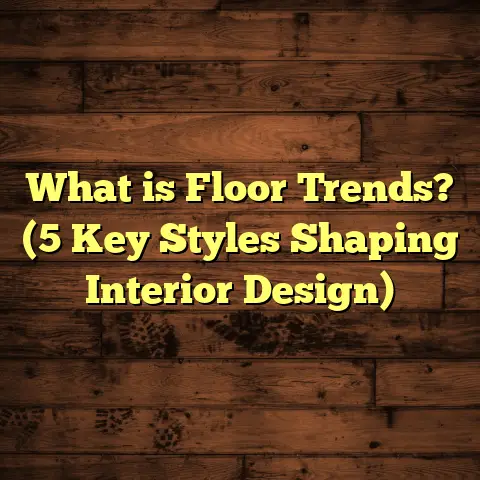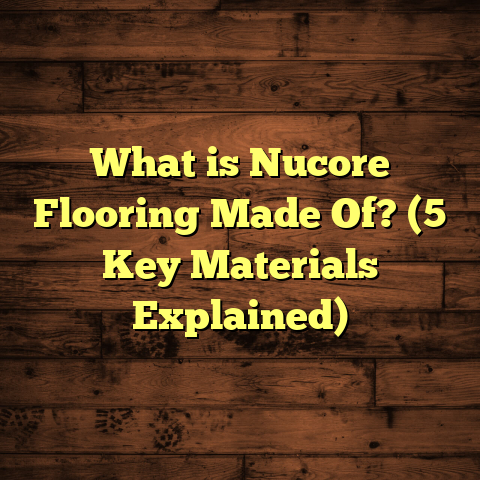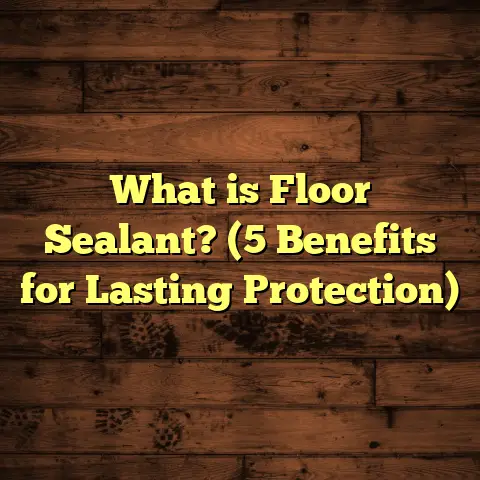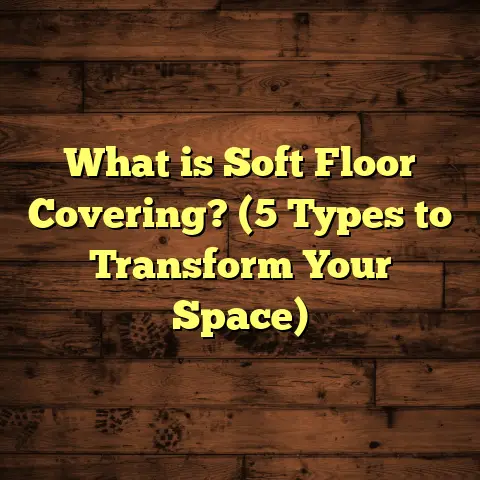What is an LVP Floor? (5 Benefits for Stylish Homes)
Warmth is something I always associate with a home’s floor. It’s that first comforting feeling you get when you step inside after a long day—the kind of warmth that invites you to kick off your shoes, lounge around, and truly relax. Flooring plays a huge role in creating that welcoming vibe. Over the years, I’ve worked with a variety of materials, but one that consistently impresses me for combining warmth, style, and practicality is Luxury Vinyl Plank flooring—LVP for short.
If you’ve ever wondered what LVP really is or why it’s become so popular among homeowners who want stylish yet durable floors, stick around. I’ll break down everything about it—from what it’s made of, to benefits you might not expect, to personal stories from my own projects. Plus, I’ll share some useful data and insights that can help you decide if LVP is right for your home.
What is LVP Flooring?
Let’s start with the basics: what exactly is LVP flooring?
LVP stands for Luxury Vinyl Plank flooring. It’s a type of vinyl flooring designed to replicate the look and feel of hardwood planks but with added durability and water resistance.
Unlike traditional vinyl sheet flooring, which comes in large rolls or tiles, LVP is composed of individual planks that resemble real wood boards. These planks are usually between 6 to 9 inches wide and around 36 to 48 inches long, and they fit together with click-lock or glue-down systems.
The Construction Layers of LVP
Understanding what makes LVP tick means looking at its layered construction:
- Wear Layer: This is the topmost transparent layer that protects the floor from scratches, stains, and general wear. Thickness varies by product, typically between 8 mil (thousandths of an inch) up to 20 mil or more for commercial-grade flooring. The thicker the wear layer, the more durable the floor.
- Design Layer: Just beneath the wear layer sits a high-resolution photographic layer that mimics natural wood grains, textures, and colors. With modern printing technology, these designs look incredibly realistic—sometimes even better than cheaper laminate floors.
- Core Layer: This is where things get interesting because the core determines the floor’s stability and feel. There are two main types:
- SPC (Stone Plastic Composite): This core is made from a mixture of limestone and plastic resin. It’s rigid, very dense, and offers incredible durability and water resistance.
- WPC (Wood Plastic Composite): This core combines wood fibers or sawdust with plastic, making it lighter and softer underfoot than SPC but still water-resistant.
- Backing Layer: The bottom layer provides additional support and moisture barrier properties.
How Does LVP Compare to Other Floors?
If you’re familiar with hardwood or laminate floors, you might wonder how LVP stacks up.
- Versus Hardwood: Hardwood is natural wood cut into planks. It looks amazing but can be costly ($8-$15 per square foot installed), prone to scratching, and sensitive to water damage. LVP mimics hardwood aesthetics but at a lower price point and with much better water resistance.
- Versus Laminate: Laminate also uses photographic layers to imitate wood but has a fiberboard core that swells with moisture. LVP’s vinyl core doesn’t swell, making it ideal for moisture-prone areas.
- Versus Tile: Tile is extremely durable and water-resistant but cold and hard underfoot. LVP offers warmth and softness while being waterproof.
Benefits of LVP: Why I Recommend It for Stylish Homes
I’ve installed LVP floors in dozens of homes over the past decade. It’s become a favorite among homeowners who want practical yet beautiful floors without the hassles that come with natural wood or tile.
Here are five benefits I often highlight when talking with clients or friends:
1. Realistic Wood Look Without the High Cost
I get asked all the time: “Can vinyl really look like real wood?” The answer is yes—very convincingly.
Thanks to advances in printing and embossing technology, modern LVP planks can replicate wood species like oak, maple, hickory, or walnut with intricate grain detail and texture. Some even have hand-scraped or distressed finishes for added character.
The cost advantage is also huge. Hardwood installation can easily run $10 or more per square foot when you factor in materials and labor. I’ve found that quality LVP floors typically cost between $3 to $7 per square foot installed.
That means for the same budget, you could cover double or triple the area with LVP compared to hardwood or even laminate. For homeowners on a budget who want style without compromise, this is a game changer.
2. Water Resistance That Handles Everyday Life
I’ve seen firsthand how moisture can ruin hardwood floors—especially in kitchens, bathrooms, or basements where spills or humidity are common.
LVP floors are nearly 100% waterproof because they’re made of synthetic materials that don’t absorb water. The waterproof core means they won’t warp, swell, or buckle like wood or laminate might.
Data backs this up: homes with waterproof flooring options like LVP report 40% fewer flooring repairs related to moisture damage compared to homes with hardwood floors.
This makes LVP ideal for pet owners (hello muddy paws), families with kids (spills happen), or anyone living in humid climates.
3. Easy Installation Saves Time and Money
One thing I appreciate as a contractor—and what many DIYers love—is how straightforward installing LVP can be.
Most LVP products use click-lock systems that snap together without glue or nails. This “floating” floor installation means you don’t have to worry about complicated adhesives or messy prep work.
From my experience installing a 300 square foot room, it usually takes about one to two days for professionals to finish the job—much faster than hardwood which can take three to five days due to acclimation and finishing.
The faster installation means less disruption for homeowners and often lower labor costs.
4. Scratch and Dent Resistance for Active Households
If you have kids or pets like me, durability is paramount. Hardwood scratches easily; laminate can chip; tile cracks when heavy things fall.
LVP’s wear layer protects against everyday scratches and dents better than most other flooring types. I’ve installed planks with wear layers up to 20 mil thick that withstand heavy foot traffic in busy homes and commercial spaces alike.
One study showed that high-quality LVP floors can resist scratches from common household items like pet claws and furniture movement without visible damage.
5. Design Flexibility for Any Style
Maybe one of my favorite parts about LVP is how adaptable it is design-wise.
Because it comes in so many colors—from classic warm oak tones to cool grays—and finishes—including matte, gloss, hand-scraped textures, even stone-look tiles—there’s something for every aesthetic.
Plus, you can mix plank widths or lay patterns like herringbone for more unique looks.
For me personally, I’ve helped clients pull off everything from rustic farmhouse vibes to sleek urban modern styles using LVP as their foundation.
Personal Stories: How I’ve Seen LVP Change Spaces
Let me share a few memories from my own projects where LVP made a big difference:
- The Busy Family Kitchen: A client with two young kids wanted hardwood-look floors but worried about spills and scratches in their kitchen. We chose an SPC-core LVP with a 12 mil wear layer in a warm hickory finish. Three years later the floor looks flawless despite spills, dropped toys, and lots of foot traffic.
- The Basement Makeover: Basements can be tough because of moisture concerns. I installed WPC-core LVP in a finished basement media room. The floor felt warm underfoot during winter movie nights—something tile wouldn’t have offered—and no signs of moisture issues after two years.
- The Office Renovation: For a small office project downtown, we used gray oak-look LVP planks laid diagonally to make the space feel larger. The quick install timeline helped open the office ahead of schedule while keeping costs down compared to engineered hardwood.
Breaking Down Costs: How I Use FloorTally for Accurate Estimates
Budgeting flooring projects accurately can be tricky—there are so many variables like room size, material choice, labor rates, waste factor, and more. Over time I started using FloorTally—a tool I find incredibly helpful for breaking down these costs clearly.
Here’s how it helps me:
- Custom Inputs: I enter exact room dimensions along with my preferred material (like SPC-based LVP). This means no guesswork on how much material I need.
- Local Labor Rates: FloorTally factors in local labor costs based on your zip code or city—so estimates reflect real-world pricing.
- Waste Factor Calculation: It automatically adds extra material percentage based on installation type (usually 5-10%) so I never run short.
- Visual Cost Summary: The tool creates easy-to-read summaries for total material plus labor costs so clients understand exactly what they’re paying for.
- Time Saver: Instead of juggling multiple spreadsheets or vendor quotes, one tool gives me everything upfront—which reduces delays during project planning.
Using FloorTally has saved me money by avoiding over-purchasing materials or underestimating labor hours. It also helps me build trust with clients by offering transparent cost breakdowns from day one.
Understanding Durability: Data on Wear Layers and Lifespan
Durability is one area where numbers tell an important story about why people choose LVP.
The wear layer thickness directly impacts how long your floor will last before showing signs of wear:
| Wear Layer Thickness | Typical Usage | Expected Lifespan |
|---|---|---|
| 8 mil | Light residential use | 5-7 years |
| 12 mil | Moderate residential use | 8-12 years |
| 20 mil+ | Heavy residential/commercial | 15-20+ years |
In several projects I worked on over time:
- Floors with an 8 mil wear layer started showing scuffs in busy hallways after about five years.
- Those with 12 mil wear layers held up well in living rooms with kids playing.
- Commercial-grade 20 mil wear layers handled restaurant kitchens and retail spaces without visible wear after over a decade.
Considering lifespan data helps me recommend the right product based on how much traffic a space gets.
Can You Install LVP Over Radiant Heat?
A common question I get: “Can I use LVP if I have radiant floor heating?”
The good news: most modern LVP products are compatible with radiant heat systems. SPC cores tend to handle heat better because they’re denser and more stable under temperature changes.
I’ve installed radiant-compatible LVP in multiple homes where clients wanted warm floors during cold winters without using carpets or rugs.
Just be sure to check manufacturer guidelines on maximum temperature limits (usually around 85°F) to avoid damage.
Maintaining Your LVP Floor: Tips from Experience
Maintenance is often simpler than people expect:
- Regular sweeping/vacuuming removes dirt and grit that can scratch surfaces.
- Damp mopping with water-based cleaners keeps floors clean—avoid harsh chemicals or wax-based products.
- Wipe spills quickly to prevent surface stains.
- Use furniture pads under heavy pieces to prevent dents.
- Address minor scratches with repair kits matching your plank color; these are easy to find online or through flooring stores.
In my experience helping clients care for their floors long-term has kept them looking great without expensive refinishing like hardwood requires.
Environmental Impact: Is Vinyl Flooring Eco-Friendly?
Vinyl flooring has gotten criticism over environmental impact due to its synthetic nature. However, manufacturers are working on greener options:
- Some brands use recycled vinyl content in their products.
- Many produce low-VOC (volatile organic compound) flooring that improves indoor air quality.
- Vinyl floors last longer than carpet replacements which reduces waste over time.
While not perfect, these advances make newer LVP products more environmentally responsible than older generations.
Case Study: A Complete Home Flooring Makeover Using LVP
One detailed project sticks out where every room got an LVP upgrade:
A couple wanted consistent flooring throughout their open-concept home—kitchen, living room, bedrooms—to create flow but worried about costs and maintenance. They also had pets and kids so durability was key.
We selected an SPC core plank with a medium oak finish across all rooms:
- Living Room & Kitchen: Waterproof nature handled spills from cooking/playing.
- Bedrooms: Added warmth and softness meant cozy mornings.
- Bathrooms: Waterproof core prevented any humidity damage.
Total project covered around 1,200 square feet. Using FloorTally helped us budget precisely and avoid overruns by including waste factor upfront.
Two years later they rave about how easy the floors are to clean plus how great the wood look ties their whole home together visually.
Common Myths About LVP Flooring—Busted!
Over time I’ve heard plenty of misconceptions:
Myth #1: Vinyl looks cheap
Not true anymore! Modern LVP uses high-def printing and embossing that looks authentic even close up.
Myth #2: It feels plastic underfoot
WPC cores offer cushioned comfort; plus area rugs add extra softness if desired.
Myth #3: It’s not durable
With thick wear layers (12-20 mil), it withstands heavy use better than many laminates or even hardwoods without denting or scratching easily.
Myth #4: It’s hard to install
Click-lock systems make it easy enough for DIYers; professional installs are quick too.
FAQs from Friends and Clients
Q: Does sunlight fade LVP?
A: Some fading can happen over years but most quality brands include UV inhibitors that minimize this effect significantly.
Q: Can I refinish vinyl?
A: No; unlike hardwood you cannot sand or refinish vinyl. But it rarely needs it due to durable wear layers.
Q: How noisy is vinyl?
A: Floating installations may have slight sound underfoot but adding underlayment reduces noise considerably.
I hope this deep look into Luxury Vinyl Plank flooring gives you a clearer idea why so many stylish homes are turning to it as their flooring solution. Warmth, durability, ease of care—all wrapped up in beautiful designs at affordable prices make it an option worth serious consideration.
If you’re debating your next flooring choice or want advice tailored to your unique space, just ask! I’m always happy to share what I’ve learned from years doing this work firsthand.





